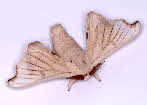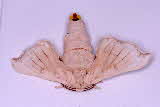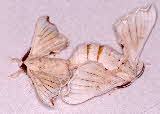|

The moth is ready to emerge about two weeks after the silkworm started to spin the cocoon. At dawn, the moth squirts a liquid containing enzyme that partially dissolves the silk threads near to the head creating a circular hole in the top of the cocoon. The moth then laboriously pushes itself out through the hole. The wings are crumpled when the moth emerges and the moth pumps blood into the wings extending them. The wings are relatively small and the adult moths cannot fly.
Female moths have a large abdomen full of eggs and don’t move much. Soon after emerging, the moth sticks out a special gland at the end of the abdomen and starts to exude a pheromone to attract a mate. Male moths are smaller and more active. When they detect a female, they scurry along towards it making a buzzing sound with their fluttering wings. The moths copulate end to end, sometimes within minutes of emerging from the cocoon and they can stay paired for several hours.
A few hours after disengaging from the male, the female starts to lay eggs. It can take a couple of days to lay 200-300 pale yellow eggs. In a couple of days, fertile eggs change to a brownish colour. In some types of silkworm (multivoltine), the eggs will hatch in the same season, while in other types (univoltine) they will hatch in the following spring.
The moths do not have functional mouths, they do not eat and they die after one or two weeks.
|

|

|

|
|
Male Mulberry silkmoth
|
Female Mulberry silkmoth
|
Mulberry silkmoths mating
|
|

|

|

|
|
Mulberry silkmoths mating
|
Mulberry silkmoths mating
|
Mulberry silkmoths mating
|
Back to Silkworm Life Cycle
Top of page
|

